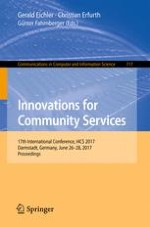2017 | Buch
Innovations for Community Services
17th International Conference, I4CS 2017, Darmstadt, Germany, June 26-28, 2017, Proceedings
herausgegeben von: Gerald Eichler, Christian Erfurth, Günter Fahrnberger
Verlag: Springer International Publishing
Buchreihe : Communications in Computer and Information Science
